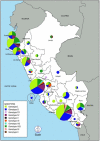Characterization of influenza A(H1N1)pdm09 isolates of Peru using HRM, a post PCR molecular biology method
- PMID: 31787813
- PMCID: PMC6859703
- DOI: 10.6026/97320630015640
Characterization of influenza A(H1N1)pdm09 isolates of Peru using HRM, a post PCR molecular biology method
Abstract
Influenza caused by A(H1N1)pdm09 is a public health issue with severe conditions in vulnerable populations leading to death. Therefore, it is of interest to characterize and monitor influenza A(H1N1)pdm09 genotypes using High Resolution Melting (HRM), a post PCR molecular biology method. We used HRM analysis (using RotorGene Q thermocycler) to characterize A(H1N1)pdm09 genotypes from several places of Peru. RNA was purified from nasal and pharyngeal swab samples referred to LRNVR-INS, synthesized cDNA, and then the hemagglutinin gene and matrix fragment were amplified. Thus, 287 samples positive for influenza A(H1N1)pdm09 were identified across Peru where places like Lima, Piura, and Arequipa documented highest number of cases. The HRM data was analyzed and results showed different profiles which were further grouped into four genotypes for the HA (A, B, C, D) and 3 for the M (a, b, c) genes. We also report ten genotypes (I-X) of virus using combined HA (hemagglutinin) and M gene profiles representing a national geography. The prevalent genotypes are I and II with a frequency of 35.89% (103) and 29.27% (84), respectively linking with severe acute respiratory infection.
Keywords: Genotype; H1N1 Influenza Virus Subtype A; High Resolution Melting.
© 2019 Biomedical Informatics.
Conflict of interest statement
The authors declare no conflicts of interest
Figures



Similar articles
-
Molecular characterization of the influenza A(H1N1)pdm09 isolates collected in the 2015-2016 season and comparison of HA mutations detected in Turkey since 2009.J Med Virol. 2019 Dec;91(12):2074-2082. doi: 10.1002/jmv.25565. Epub 2019 Aug 20. J Med Virol. 2019. PMID: 31389035
-
Phylogenetic analysis of the hemagglutinin gene of influenza A(H1N1)pdm09 and A(H3N2) virus isolates from Haryana, India.Virusdisease. 2019 Sep;30(3):336-343. doi: 10.1007/s13337-019-00532-7. Epub 2019 May 10. Virusdisease. 2019. PMID: 31803799 Free PMC article.
-
Pathogenicity and transmissibility of novel reassortant H3N2 influenza viruses with 2009 pandemic H1N1 genes in pigs.J Virol. 2015 Mar;89(5):2831-41. doi: 10.1128/JVI.03355-14. Epub 2014 Dec 24. J Virol. 2015. PMID: 25540372 Free PMC article.
-
Molecular epidemiology of the hemagglutinin gene of prevalent influenza virus A/H1N1/pdm09 among patient in Iran.Virus Res. 2019 Jan 2;259:38-45. doi: 10.1016/j.virusres.2018.10.001. Epub 2018 Oct 15. Virus Res. 2019. PMID: 30336188
-
A(H1N1)pdm09 hemagglutinin D222G and D222N variants are frequently harbored by patients requiring extracorporeal membrane oxygenation and advanced respiratory assistance for severe A(H1N1)pdm09 infection.Influenza Other Respir Viruses. 2013 Nov;7(6):1416-26. doi: 10.1111/irv.12146. Epub 2013 Aug 9. Influenza Other Respir Viruses. 2013. PMID: 23927713 Free PMC article.
References
-
- Fields B, et al. Fields virology. 5th. Philadelphia: Wolters Kluwer Health Lippincott Williams and Wilkins. 2007
-
- Salazar M, et al. Gac Med Mex. 2010;146:199. - PubMed
-
- Wright P, et al. Orthomyxo viruses. In: Knipe DM, Howley PM, editors. Fields Virology. 5 ed. Philadelphia, PA 19106 USA: LIPPINCOTT WILLIAMS and WILKINS, a WOLTERS KLUWER BUSINESS. . 2007;1691
LinkOut - more resources
Full Text Sources
